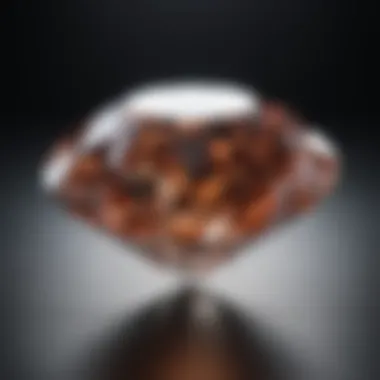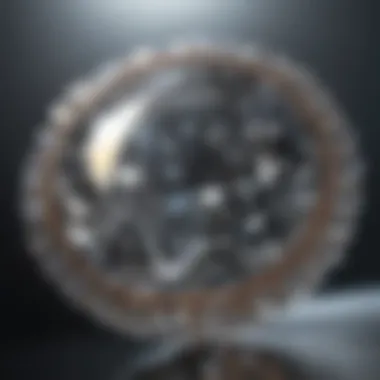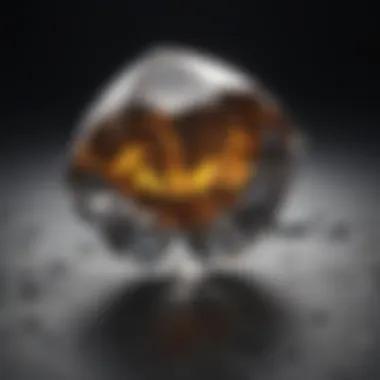Unveiling the Intricacies of the Diamond Clarity Scale: A Comprehensive Guide


Diamond clarity is a fundamental aspect when evaluating the quality and value of these precious gemstones. Understanding the intricacies of the clarity scale is crucial for discerning buyers and enthusiasts alike. In this comprehensive guide, we will delve deep into the various facets of diamond clarity, shedding light on its significance in the world of gemstones.
Overview of Gemstones and Minerals
Gemstones have held a significant place in human history and culture, revered for their beauty and mystique. Their use dates back centuries, with cultures around the world valuing these precious stones for various purposes. In today's society, gemstones continue to captivate us with their allure and symbolic meanings.
Gemstone Formation and Properties
The formation process of gemstones is a fascinating journey that spans millions of years. These natural treasures are created deep within the Earth's crust under intense pressure and heat. Gemstones possess unique properties that set them apart from common minerals, including exceptional color, hardness, and luster, making them highly sought after for jewelry and ornamental purposes.
Types of Gemstones
Within the world of gemstones, distinctions are made between precious and semi-precious varieties. While precious gemstones like diamonds, rubies, sapphires, and emeralds hold high value, semi-precious stones like amethyst, topaz, and garnet are more accessible. Additionally, there are exotic and rare gemstones that appeal to collectors and connoisseurs due to their scarcity and remarkable beauty.
Identifying and Evaluating Gemstones
Evaluating gemstones involves considering various factors that impact their value and quality. Professionals use specialized techniques for gemstone identification, taking into account characteristics such as color, clarity, cut, and carat weight. Assessing gemstone quality requires a keen eye and understanding of industry standards to ensure buyers receive authentic and valuable stones.
Caring for Gemstones
Proper care and maintenance are essential for preserving the beauty and longevity of gemstones. Cleaning and storing gemstones correctly can prevent damage and maintain their brilliance over time. By avoiding common mistakes in gemstone care and following preservation tips tailored to specific gem types, enthusiasts can enjoy their precious stones for generations to come.
Introduction
The diamond clarity scale is a critical aspect of evaluating the quality and value of these precious gemstones. Understanding diamond clarity is essential for anyone involved in gemstone evaluation, be it enthusiasts, collectors, jewelry designers, or geology enthusiasts. Exploring the clarity scale allows individuals to grasp the intricate details that define a diamond's worth and beauty.
What is Diamond Clarity?
Defining clarity in the context of diamonds
Delving into the realm of diamond clarity involves dissecting the imperfections within a diamond that affect its overall appearance and value. Every natural diamond contains internal characteristics known as inclusions and external features termed blemishes, which collectively form the clarity grade of a diamond. These characteristics play a pivotal role in determining a diamond's uniqueness and value in the market.
The impact of clarity on a diamond's value


The impact of clarity on a diamond's value cannot be understated. Diamonds with higher clarity grades command higher prices due to their rarity and visual appeal. Clarity significantly influences how light interacts with the diamond, affecting its brilliance and sparkle. Understanding how clarity impacts a diamond's value is crucial for making informed purchases and investments in these exquisite gemstones.
Significance of Clarity in Diamonds
Why clarity is a crucial factor in diamond evaluation
Clarity serves as a crucial factor in diamond evaluation as it directly influences the stone's beauty and market worth. The clarity grade of a diamond provides insights into its purity and visual attractiveness, guiding buyers and sellers in making refined choices. By comprehending the significance of clarity, individuals can navigate the intricate world of diamond trading with confidence and knowledge.
Relation between clarity and diamond brilliance
The relationship between clarity and diamond brilliance is symbiotic, with clarity amplifying the stone's luminosity and fire. A diamond with excellent clarity allows light to pass through unimpeded, enhancing its brilliance and scintillation. Recognizing how clarity contributes to a diamond's brilliance empowers gemstone enthusiasts to appreciate the mesmerizing play of light within these exceptional gems.
Understanding Diamond Clarity Characteristics
In this article, the exploration of diamond clarity delves into the crucial aspects that define the quality and value of these precious gemstones. Understanding Diamond Clarity Characteristics plays a pivotal role in evaluating diamonds, as it provides insights into the inclusions and blemishes that affect a diamond's visual appearance and overall appeal. By focusing on these characteristics, readers can gain a profound understanding of how clarity impacts the brilliance and aesthetic of a diamond.
Inclusions
Types of inclusions found in diamonds contribute significantly to the overall clarity assessment of a diamond. These inclusions may include internal characteristics such as crystals, feathers, clouds, or pinpoints. The type and size of inclusions are key factors in determining a diamond's clarity grade. Understanding the different types of inclusions helps diamond enthusiasts appreciate the uniqueness of each stone, as well as how these internal features affect the diamond's quality and brilliance.
Impact of inclusions on a diamond's clarity grade further emphasizes the importance of these internal characteristics in diamond evaluation. Inclusions can range from minor imperfections to more prominent flaws that impact a diamond's visual clarity. The presence of inclusions influences the diamond's transparency and sparkle, affecting its overall appeal. By examining the impact of inclusions on a diamond's clarity grade, individuals can make informed decisions when selecting a diamond based on their clarity preferences and budget constraints.
Blemishes
Common blemishes observed in diamonds are external irregularities that affect the stone's surface appearance. These blemishes may include scratches, pits, or nicks that impact the diamond's clarity and overall visual quality. Understanding the nature of common blemishes allows enthusiasts to assess the external condition of a diamond and how it influences the stone's clarity grade.
How blemishes affect diamond clarity delves into the relationship between surface flaws and a diamond's visual appeal. Blemishes can diminish the brilliance and fire of a diamond, impacting its overall sparkle and beauty. By recognizing how blemishes affect diamond clarity, individuals can evaluate the trade-offs between clarity and other diamond characteristics when making a purchasing decision. Understanding the significance of blemishes contributes to a holistic understanding of diamond clarity and aids in selecting the perfect diamond based on personal preferences and budget considerations.
The Diamond Clarity Scale
The Diamond Clarity Scale is a vital component of evaluating the quality and value of diamonds. Within the realm of gemstone assessment, clarity holds immense significance as it directly impacts a diamond's brilliance and overall visual appeal. Understanding the intricacies of clarity is essential for gemstone enthusiasts, collectors, or those involved in designing jewelry. The Diamond Clarity Scale helps in categorizing diamonds based on the presence of inclusions and blemishes, providing a structured approach to assessing their quality and worth. By delving into this scale, individuals can make well-informed decisions when selecting diamonds for various purposes.
GIA Clarity Grading System
Overview of the Gemological Institute of America's Clarity Grading Scale


The Gemological Institute of America (GIA) Clarity Grading System is renowned for its precision and accuracy in evaluating diamond clarity. This system sets a benchmark in the industry by employing stringent criteria to assign clarity grades to diamonds. The GIA clarity grades range from Flawless (FL) to Included (I), with each grade having specific parameters and characteristics that define the level of clarity in a diamond. Due to its consistent and reliable methodology, the GIA Clarity Grading System is widely trusted by gemstone professionals and consumers alike for assessing diamond clarity.
Explanation of Different Clarity Grades
The explanation of different clarity grades within the GIA system offers a detailed insight into the various levels of clarity present in diamonds. Each clarity grade signifies the extent of inclusions and blemishes visible under magnification, thus influencing the overall purity of the diamond. By understanding the nuances of each clarity grade, individuals can determine the clarity characteristics that align with their preferences and requirements. The GIA clarity grades not only communicate the internal clarity features of a diamond but also play a pivotal role in determining its value and desirability in the market.
Other Clarity Grading Systems
Comparison of Different Diamond Clarity Scales
Comparing different diamond clarity scales provides a broader perspective on how various grading systems evaluate and categorize diamond clarity. While the GIA Clarity Grading System is widely recognized, there are other grading systems in the industry that offer alternative approaches to assessing clarity. By exploring these different scales, individuals can gain a comprehensive understanding of the diverse criteria used to determine diamond clarity, enabling them to make well-rounded assessments when examining gemstones. Understanding the differences and similarities between these clarity grading systems can enhance one's ability to discern and appreciate the intricacies of diamond clarity.
Commonly Used Clarity Grading Systems
Commonly used clarity grading systems beyond the GIA framework contribute to the nuanced landscape of diamond assessment. These alternative systems often cater to specific market segments or niche preferences, offering distinct perspectives on evaluating diamond clarity. By familiarizing oneself with the common clarity grading systems apart from GIA, individuals can broaden their knowledge and expertise in distinguishing between varying levels of clarity in diamonds. Each system's unique features and methodologies provide valuable insights into the diverse approaches taken by gemologists and industry experts in assessing and characterizing diamond clarity.
Factors Influencing Diamond Clarity
In this section on factors influencing diamond clarity, we dive deep into the critical elements that define the clarity of a diamond. Understanding these factors is paramount for individuals in the gemstone industry, collectors, and jewelry designers. The significance of these factors lies in their ability to determine the quality and value of a diamond. Factors such as the nature of inclusions and blemishes play a crucial role in assessing a diamond's clarity grade. By examining and evaluating these factors meticulously, one can make informed decisions when selecting or valuing diamonds. The balance between these influencing elements ultimately shapes the overall clarity of a diamond, influencing its brilliance and aesthetics.
Nature of Inclusions and Blemishes
How the nature and size of inclusions impact clarity
The presence of inclusions, which are internal characteristics within a diamond, directly influences its clarity grade. The size, type, and number of inclusions significantly impact the diamond's appearance and transparency. Larger or numerous inclusions may obstruct the passage of light through the stone, affecting its brilliance and sparkle. Understanding the nature of inclusions and their size allows gemologists to assign an appropriate clarity grade, reflecting the overall purity of the diamond. Assessing the impact of inclusions on clarity requires expertise and precise observation to differentiate between various inclusion types and sizes.
Relationship between blemish location and clarity grade
Blemishes, external features on a diamond's surface, also contribute to its clarity grade. The location of blemishes plays a vital role in determining the diamond's overall clarity rating. Blemishes near critical areas such as the table or facets can interfere with light reflection and scattering, diminishing the diamond's brilliance. Evaluating the relationship between blemish locations and clarity grades assists in accurately assessing a diamond's value and beauty. Gemologists scrutinize the placement and visibility of blemishes to provide an accurate representation of the diamond's clarity, guiding consumers and industry professionals in their decision-making process.
Clarity Enhancement Techniques
Common methods to improve diamond clarity
Diamond clarity enhancement techniques aim to minimize the appearance of inclusions and blemishes, thereby enhancing the stone's visual appeal. These methods may include laser drilling, fracture filling, or coating to reduce the visibility of imperfections. By employing these techniques, jewelers can elevate a diamond's clarity grade, enhancing its overall value and desirability. Understanding the common methods used to improve clarity provides insight into the processes involved in enhancing a diamond's aesthetic quality.


Implications of clarity enhancement on diamond value
While clarity enhancement techniques can enhance the visual appeal of a diamond, they may also impact its intrinsic value. Consumers and industry professionals should consider the long-term implications of clarity enhancement on a diamond's worth. Despite potential improvements in clarity grade, alterations from enhancement processes could affect the stone's durability or long-term stability. Evaluating the implications of clarity enhancement on diamond value involves weighing the benefits of enhanced aesthetics against any potential trade-offs in terms of integrity and long-term value.
Choosing a Diamond Based on Clarity
In the realm of selecting a diamond, the consideration of clarity holds immense significance. Understanding the nuances of diamond clarity is paramount when aiming to procure a gemstone of high quality and value. By meticulously evaluating the clarity characteristics of a diamond, one can ensure that the chosen gemstone possesses the desired purity and brilliance. This section delves into the key factors that come into play when choosing a diamond based on clarity, providing invaluable insights for enthusiasts and collectors alike.
Balancing Clarity and Budget
Tips for selecting a diamond with the right balance of clarity and cost
When embarking on the journey of acquiring a diamond, striking a harmonious balance between clarity and budget is crucial. Delving into this aspect unveils a realm where craftsmanship meets financial prudence. By honing in on diamonds that offer commendable clarity without exorbitant costs, individuals can ensure that they are making a prudent investment in a gemstone that exudes elegance and brilliance. This meticulous selection process not only enhances the overall aesthetic appeal of the diamond but also reflects savvy decision-making in the realm of gemstone acquisition.
Factors to consider when compromising on clarity for other diamond characteristics
Navigating the intricate world of diamonds often involves making trade-offs to prioritize certain characteristics over others. When faced with the decision to compromise on clarity for other diamond attributes, such as carat weight or cut quality, several key factors come into play. Understanding how these considerations impact the overall appeal and value of a diamond is paramount in making an informed choice. By weighing the advantages and disadvantages of such compromises, individuals can curate a collection of diamonds that cater to their specific preferences and requirements.
Personal Preferences in Diamond Clarity
How individual preferences influence the choice of diamond clarity
The allure of diamonds lies not only in their intrinsic beauty but also in their ability to resonate with individual preferences. When it comes to selecting a diamond based on clarity, personal inclinations play a pivotal role in determining the perfect gemstone. Whether prioritizing flawless clarity or embracing a more unique setting with visible inclusions, understanding how personal preferences shape the choice of diamond clarity is essential. By acknowledging and honoring these individual tastes, one can create a curated collection of diamonds that truly reflect personal style and elegance.
Customization options based on clarity preferences
In the realm of diamond selection, customization options based on clarity preferences offer a realm of possibilities for connoisseurs and collectors. From selecting specific clarity grades to incorporating bespoke designs that highlight the clarity characteristics of a diamond, the world of customization opens up a plethora of choices. Embracing these customization options allows individuals to craft a collection of diamonds that not only meet their exacting standards but also showcase the unique beauty and allure of each gemstone. By leveraging these customization features, one can elevate the experience of selecting diamonds based on clarity to a bespoke and uniquely tailored process.
Conclusion
In this conclusive segment of our in-depth exploration of the Clarity Scale for Diamonds, we unravel the essence of why understanding the significance of diamond clarity is paramount in the realm of gemstone evaluation. Delving into the core of the matter, it becomes evident that diamond clarity serves as a crucial determining factor in assessing the quality and subsequently the value of these exquisite gemstones. By comprehending the nuances of clarity characteristics and the intricacies of various grading criteria, readers are equipped with a holistic perspective on what constitutes diamond clarity.
Key Takeaways
Importance of Diamond Clarity in Gemstone Evaluation:
Embarking on an insightful journey into the realm of diamond clarity, one unveils the pivotal role it plays in the evaluation of gemstones. The importance of diamond clarity lies in its ability to act as a litmus test for the overall quality and value of a diamond. A diamond's clarity is a window into its inner world, revealing the presence or absence of imperfections that can significantly impact its brilliance and appeal. Understanding the significance of diamond clarity enhances the discernment of gemstone enthusiasts and collectors, enabling them to make informed decisions when acquiring these precious stones. The unique feature of diamond clarity lies in its transparency, providing a clear view into the purity of the diamond and influencing its desirability in the market.
Impact of Diamond Clarity on Overall Aesthetic Appeal:
Exploring the impact of diamond clarity on the aesthetic allure of a diamond uncovers a fascinating interplay between clarity and beauty. At the core of a diamond's aesthetic appeal lies its clarity, which determines the level of sparkle, brilliance, and overall visual impact. The clarity of a diamond directly influences how light interacts with the stone, resulting in the mesmerizing display of colors and reflections that captivate the beholder. The key characteristic of diamond clarity in enhancing the overall aesthetic appeal of a diamond underscores its significance in the world of jewelry design and appreciation. Despite potential challenges in achieving high clarity grades, the advantage of diamond clarity lies in its ability to elevate the beauty and elegance of a diamond, offering a timeless allure that transcends trends in the jewelry industry.







